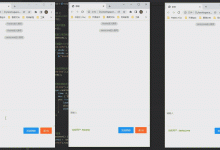AOP源码分析
gradle引入aop的依赖:
group \'org.springframework\'version \'5.1.21.BUILD-SNAPSHOT\'apply plugin: \'java\'sourceCompatibility = 1.8repositories {mavenCentral()}dependencies {compile(project(":spring-context"))compile group:\'org.aspectj\',name:\'aspectjweaver\',version: \'1.8.6\'testCompile group: \'junit\', name: \'junit\', version: \'4.12\'}
我们知道AOP的实现是使用的动态代理的方式,那必然是在创建对象的时候创建了一个代理对象。
那么代理类是什么时候创建的呢?实际上代理类的创建是通过BeanPostProcessor的后置处理来做的。
经过之前IOC源码的学习,我们可以知道,后置处理器的代码的位置。
@Overridepublic Object applyBeanPostProcessorsAfterInitialization(Object existingBean, String beanName)throws BeansException {Object result = existingBean;for (BeanPostProcessor processor : getBeanPostProcessors()) {Object current = processor.postProcessAfterInitialization(result, beanName);if (current == null) {return result;}result = current;}return result;}
它会遍历所有实现了BeanPostProcessor的Bean,其中有一个AspectJAwareAdvisorAutoProxyCreator,看名字就知道跟AOP是相关的。既然它实现了BeanPostProcessor接口,我们就要去找它的postProcessAfterInitialization方法。
当前类没有,就往父类里面找,在AbstractAutoProxyCreator里面找到
public Object postProcessAfterInitialization(@Nullable Object bean, String beanName) {if (bean != null) {Object cacheKey = getCacheKey(bean.getClass(), beanName);if (this.earlyProxyReferences.remove(cacheKey) != bean) {return wrapIfNecessary(bean, beanName, cacheKey);}}return bean;}
跟踪wrapIfNecessary方法进入
protected Object wrapIfNecessary(Object bean, String beanName, Object cacheKey) {if (StringUtils.hasLength(beanName) && this.targetSourcedBeans.contains(beanName)) {return bean;}if (Boolean.FALSE.equals(this.advisedBeans.get(cacheKey))) {return bean;}if (isInfrastructureClass(bean.getClass()) || shouldSkip(bean.getClass(), beanName)) {this.advisedBeans.put(cacheKey, Boolean.FALSE);return bean;}// 如果有设置增强的话,就创建代理对象Object[] specificInterceptors = getAdvicesAndAdvisorsForBean(bean.getClass(), beanName, null);if (specificInterceptors != DO_NOT_PROXY) {this.advisedBeans.put(cacheKey, Boolean.TRUE);Object proxy = createProxy(bean.getClass(), beanName, specificInterceptors, new SingletonTargetSource(bean));this.proxyTypes.put(cacheKey, proxy.getClass());return proxy;}this.advisedBeans.put(cacheKey, Boolean.FALSE);return bean;}
可以看出如果有设置aop相关增强的话,就会去调用createProxy方法,创建并返回代理对象。
protected Object createProxy(Class<?> beanClass, @Nullable String beanName,@Nullable Object[] specificInterceptors, TargetSource targetSource) {if (this.beanFactory instanceof ConfigurableListableBeanFactory) {AutoProxyUtils.exposeTargetClass((ConfigurableListableBeanFactory) this.beanFactory, beanName, beanClass);}ProxyFactory proxyFactory = new ProxyFactory();proxyFactory.copyFrom(this);if (!proxyFactory.isProxyTargetClass()) {if (shouldProxyTargetClass(beanClass, beanName)) {proxyFactory.setProxyTargetClass(true);}else {evaluateProxyInterfaces(beanClass, proxyFactory);}}Advisor[] advisors = buildAdvisors(beanName, specificInterceptors);proxyFactory.addAdvisors(advisors);proxyFactory.setTargetSource(targetSource);customizeProxyFactory(proxyFactory);proxyFactory.setFrozen(this.freezeProxy);if (advisorsPreFiltered()) {proxyFactory.setPreFiltered(true);}return proxyFactory.getProxy(getProxyClassLoader());}
我们点proxyFactory.getProxy这个方法,发现他有两个实现。
接下来就会根据这两个不同的实现创建出代理对象,对原方法进行增强。

 爱站程序员基地
爱站程序员基地

